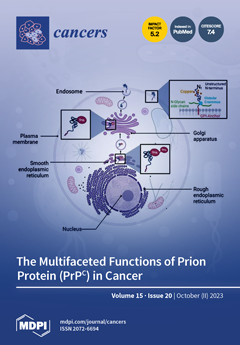Purpose: In 2021, the WHO central nervous system (CNS) tumor classification criteria added the diagnosis of diffuse astrocytic glioma, IDH wild-type, with molecular features of glioblastoma, WHO grade 4 (DAG-G). DAG-G may exhibit the aggressiveness and malignancy of glioblastoma (GBM) despite the lower
[...] Read more.
Purpose: In 2021, the WHO central nervous system (CNS) tumor classification criteria added the diagnosis of diffuse astrocytic glioma, IDH wild-type, with molecular features of glioblastoma, WHO grade 4 (DAG-G). DAG-G may exhibit the aggressiveness and malignancy of glioblastoma (GBM) despite the lower histological grade, and thus a precise preoperative diagnosis can help neurosurgeons develop more refined individualized treatment plans. This study aimed to establish a predictive model for the non-invasive identification of DAG-G based on preoperative MRI radiomics. Patients and Methods: Patients with pathologically confirmed glioma in Huashan Hospital, Fudan University, between September 2019 and July 2021 were retrospectively analyzed. Furthermore, two external validation datasets from Wuhan Union Hospital and Xuzhou Cancer Hospital were also utilized to verify the reliability and accuracy of the prediction model. Two regions of interest (ROI) were delineated on the preoperative MRI images of the patients using the semi-automatic tool ITK-SNAP (version 4.0.0), which were named the maximum anomaly region (ROI1) and the tumor region (ROI2), and Pyradiomics 3.0 was applied for feature extraction. Feature selection was performed using a least absolute shrinkage and selection operator (LASSO) filter and a Spearman correlation coefficient. Six classifiers, including Gauss naive Bayes (GNB), K-nearest neighbors (KNN), Random forest (RF), Adaptive boosting (AB), and Support vector machine (SVM) with linear kernel and multilayer perceptron (MLP), were used to build the prediction models, and the prediction performance of the six classifiers was evaluated by fivefold cross-validation. Moreover, the performance of prediction models was evaluated using area under the curve (AUC), precision (PRE), and other metrics. Results: According to the inclusion and exclusion criteria, 172 patients with grade 2–3 astrocytoma were finally included in the study, and a total of 44 patients met the diagnosis of DAG-G. In the prediction task of DAG-G, the average AUC of GNB classifier was 0.74 ± 0.07, that of KNN classifier was 0.89 ± 0.04, that of RF classifier was 0.96 ± 0.03, that of AB classifier was 0.97 ± 0.02, that of SVM classifier was 0.88 ± 0.05, and that of MLP classifier was 0.91 ± 0.03, among which, AB classifier achieved the best prediction performance. In addition, the AB classifier achieved AUCs of 0.91 and 0.89 in two external validation datasets obtained from Wuhan Union Hospital and Xuzhou Cancer Hospital, respectively. Conclusions: The prediction model constructed based on preoperative MRI radiomics established in this study can basically realize the prospective, non-invasive, and accurate diagnosis of DAG-G, which is of great significance to help further optimize treatment plans for such patients, including expanding the extent of surgery and actively administering radiotherapy, targeted therapy, or other treatments after surgery, to fundamentally maximize the prognosis of patients.
Full article






